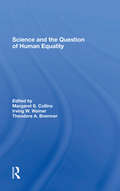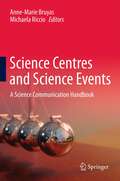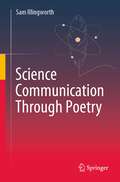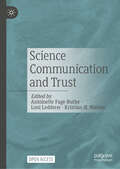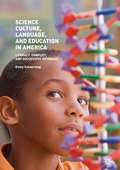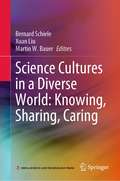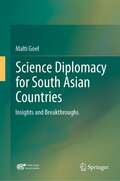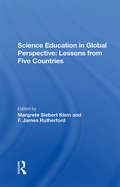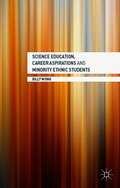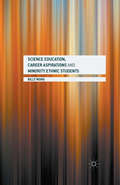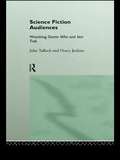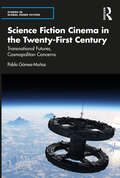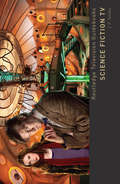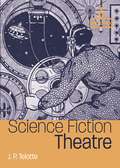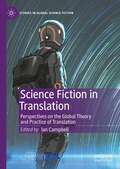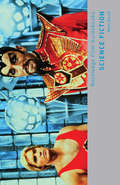- Table View
- List View
Science And The Question Of Human Equality
by Margaret S Collins Irving W Wainer Theodore A. BremnerThis book provides an interdisciplinary look at racism and science, investigating the biological and social realities of individual and group differences. The contributors examine race and racial distinctions, environmental versus genetic contributions to IQ and to cognitive skill level, the impact of biocultural interactions on behavior, and the problems of achieving an objective appraisal of inter- and intragroup differences in humans. They also consider a possible model for cultural and biological evolution, recommending a careful selection of models and methods of approach for sciences concerned with the study of man. The book includes recent findings in the area of race and IQ, documents instances of racism and classism, and analyzes factors underlying these phenomena.
Science As Social Knowledge: Values And Objectivity In Scientific Inquiry
by Helen E. Longino<P> Conventional wisdom has it that the sciences, properly pursued, constitute a pure, value-free method of obtaining knowledge about the natural world. <P>In light of the social and normative dimensions of many scientific debates, Helen Longino finds that general accounts of scientific methodology cannot support this common belief. Focusing on the notion of evidence, the author argues that a methodology powerful enough to account for theories of any scope and depth is incapable of ruling out the influence of social and cultural values in the very structuring of knowledge. <P>The objectivity of scientific inquiry can nevertheless be maintained, she proposes, by understanding scientific inquiry as a social rather than an individual process. Seeking to open a dialogue between methodologists and social critics of the sciences, Longino develops this concept of "contextual empiricism" in an analysis of research programs that have drawn criticism from feminists. <P>Examining theories of human evolution and of prenatal hormonal determination of "gender-role" behavior, of sex differences in cognition, and of sexualorientation, the author shows how assumptions laden with social values affect the description, presentation, and interpretation of data. <P>In particular, Longino argues that research on the hormonal basis of "sex-differentiated behavior" involves assumptions not only about gender relations but also about human action and agency. She concludes with a discussion of the relation between science, values, and ideology, based on the work of Habermas, Foucault, Keller, and Haraway.
Science Centres and Science Events
by Anne-Marie Bruyas Michaela RiccioThe idea for this text stemmed from the fruitful experience gathered during the training course of 9 Nigerian university students organized in Naples from 3 to 18 September 2008 by the team of Fondazione IDIS-Città della Scienza under the project Science Centre Owerri. The training course turned out to be not only an educational opportunity to acquire knowledge and skills for these students, but also a real and practical tool that later led to the realization of the first Science Festival of Owerri in Nigeria in May 2009. This in turn sparked the idea of creating a highly practical handbook for those who want to face the challenge of developing new projects for the dissemination and socialization of science in developing countries. In these countries, the role of scientific education and training in schools is not sufficient to arouse scientific curiosity among young people and make the population aware of the importance of scientific knowledge in everyday life. Moreover science and technology are indispensable tools for people's empowerment and should be supported with actions that encourage curiosity about science and the intelligent use of technology to bridge the divide with developed countries. It is therefore necessary to set up activities that are carefully targeted to promote and communicate science. The text has been designed as a practical guide to be used in a variety of contexts: scientific events or more structured science festivals, training, the creation of scientific cultural associations, and the development of new science centres. Besides being an excellent tool for training and supporting the design and planning phases, the manual can also be used as a reference work for institutions and local cultural services which have to select projects of this type.
Science Communication Through Poetry
by Sam IllingworthScience Communication Through Poetry aims to explore how we might communicate science effectively both to and with non-scientific audiences across the spectrum of science communication, from dissemination to dialogue, via the medium of poetry. It has been written for scientists, science communicators, public engagement practitioners, and poets, so that they can learn how to use poetry as an effective tool through which to diversify science. As well as containing specific advice and guidance for how to use poetry to communicate science with different audiences, this book contains a number of exercises for the reader to reflect on what has been learnt and to put into practice what is discussed. Further study and additional readings are also provided to help improve knowledge, understanding, and familiarity with both poetry and science communication.
Science Communication and Trust
by Antoinette Fage-Butler Loni Ledderer Kristian H. NielsenThis open access book presents groundbreaking research, offering new empirical findings, showcasing a range of different methods, and advancing theoretical perspectives relating to science communication and trust. The investigation of science communication and trust is enhanced by the many international scholars and disciplinary approaches featured. The book includes three thematic sections: the first focuses on the role of trustworthy science communicators, the second is concerned with the varying contexts of science communication for trust, while the third unpacks various features of trust in science. The volume thus provides the reader with invaluable insights into the highly salient topic of science communication and trust.
Science Culture, Language, and Education in America: Literacy, Conflict, And Successful Outreach
by Emily SchoerningCan the culture and language of science be an alienating force that discourages marginalized people from identifying with scientists and pursuing higher education in the sciences? More broadly, does an education system which unwittingly presents science as a distinct culture result in a population susceptible to doubt, confusion, and denial? This volume explores how this 'culture of science' is reflected and transmitted in the classroom, and how this can have wide-reaching and often negative implications for science education and science literacy. Well-intentioned efforts to bring hands-on scientific experiences into the classroom must also take into account how students perceive the culture of science. Areas of potential conflict include linguistic and cultural behaviors, misconceptions about science and the nature of science, and, in some cases, religious worldviews. Once recognized, these conflicts are resolvable, and valid methods exist to reduce alienation, broaden participation, and ensure that all students, whether or not they pursue STEM careers, leave school knowing that science is something that they can trust.
Science Cultures in a Diverse World: Knowing, Sharing, Caring
by Xuan Liu Bernard Schiele Martin W. BauerScience and technology culture is now more than ever at the very heart of the social project, and all countries, to varying degrees, participate in it: raising scientific literacy, improving the image of the sciences, involving the public in debates and encouraging the young to pursue careers in the sciences. Thus, the very destiny of any society is now entwined with its ability to develop a genuine science and technology culture, accessible for participation not only to the few who, by virtue of their training or trade, work in the science and technology fields, but to all, thereby creating occasions for society to debate and to foster a positive dialogue about the directions of change and future choices.This book organized on the theme of ‘knowing, sharing, caring: new insights for a diverse world’, which was derived from the observation that globalization rests upon diversity—diversity of contexts, publics, research, strategies and new innovating practices—and aims to stimulate exchanges, discussions and debates, to initiate a reflection conducive to decentring and to be an opportunity for enrichment by providing the reader with means to achieve the potentialities of that diversity through a comparison of the visions that underpin the attitudes of social actors, the challenges they perceive and the potential solutions they consider.Thus, this book aims first and foremost to raise questions in such a manner that readers so stimulated will feel compelled to contribute and will do so. In this spirit, however significant, the results presented and shared are less important than the questions they seek to answer: How are we to rethink the diffusion, the propagation and the sharing of scientific thought and knowledge in an ever more complex and diverse world? What to know? What to share? How do we do it when science is broken down across the whole spectrum of the world’s diversity?The book is recommended for those who are interested in science communication and science cultures in the new media era, in contemporary social dynamics, and in the evolution of the role of the state and of institutions. It is also an excellent reference for researchers engaging in science communication, public understanding of science, cultural studies, science and technology museum, science–society relationship and other fields of humanities and social sciences.
Science Diplomacy for South Asian Countries: Insights and Breakthroughs
by Malti GoelThis book provides a science diplomacy outlook as a new governance tool in international cooperation. It elaborates on India's current S&T collaboration with Afghanistan, Bangladesh, Bhutan, Maldives, Myanmar, Nepal, Pakistan, Sri Lanka, and science policy and science diplomacy in India. The book introduces concepts and contours of science diplomacy with international examples. It presents insights into international governance models, mega-science projects, and science diplomacy's role in addressing global climate change and sustainable development challenges. The book is a valuable reference to spark breakthroughs in India’s science diplomacy with its neighbouring countries for scientists, diplomats, policymakers, government, and non-government institutions interested in science and diplomacy.
Science Education In Global Perspective: Lessons From Five Countries
by Margrete Siebert Klein F. James Rutherford F James Rutherford Margrete S. KleinThe decline in the quality of American public school instruction, particularly in science and mathematics, is a well-documented subject of concern for our nation. This book examines the educational systems in Japan, the People's Republic of China, East and West Germany, and the Soviet Union, countries that have developed particularly innovative app
Science Education, Career Aspirations and Minority Ethnic Students
by Billy WongIs science typically for White men? Is science for 'people like us'? What are the barriers and opportunities? This book explores the science career aspirations of minority ethnic students. It investigates the views, experiences and identities of British Black Caribbean, Bangladeshi, Chinese, Indian and Pakistani youths in relation to science.
Science Education, Career Aspirations and Minority Ethnic Students
by Billy WongIs science typically for White men? Is science for 'people like us'? What are the barriers and opportunities? This book explores the science career aspirations of minority ethnic students. It investigates the views, experiences and identities of British Black Caribbean, Bangladeshi, Chinese, Indian and Pakistani youths in relation to science.
Science Fiction - The Evolutionary Mythology of the Future: Prometheus to the Martians
by Thomas LombardoAn evolutionary and transformative journey through the history of science fiction from the innermost passions and dreams of the human spirit to the farthest reaches of the universe, human imagination, and beyond.
Science Fiction Audiences: Watching Star Trek and Doctor Who (Popular Fictions Series)
by Henry Jenkins John TullochScience Fiction Audiences examines the astounding popularity of two television "institutions" - the series Doctor Who and ^Star Trek. Both of these programmes have survived cancellation and acquired an following that continues to grow. The book is based on over ten years of research including interviews with fans and followers of the series. In that period, though the fans may have changed, and ways of studying them as "audiences" may have also changed, the programmes have endured intact, with Star Trek for example now in its fourth television incarnation. John Tulloch and Henry Jenkins dive into the rich fan culture surrounding the two series, exploring issues such as queer identity, fan meanings, teenage love of science fiction, and genre expectations. They encompass the perspectives of a vast population of fans and followers throughout Britain, Australia and the US, who will continue the debates contained in the book, along with those who will examine the historically changing range of audience theory it presents. and continue to attract a huge community of fans and followers. Doctor Who has appeared in nine different guises and Star Trek is now approaching its fourth television incarnation.Science Fiction Audiences examines the continuing popularity of two television 'institutions' of our time through their fans and followers. Through dialogue with fans and followers of Star Trek and Dr Who in the US, Britain and Australia, John Tulloch and Henry Jenkins ask what it is about the two series that elicits such strong and active responses from their audiences. Is it their particular intervention into the SF genre? Their expression of peculiarly 'American' and 'British' national cultures. Their ideologies and visions of the future, or their conceptions of science and technology? Science Fiction Audiences responds to a rich fan culture which encompasses debates about fan aesthetics, teenage attitudes to science fiction, queers and Star Trek, and ideology and pleasure in Doctor Who. It is a book written both for fans of the two series, who will be able to continue their debates in its pages, and for students of media and cultural studies, offering a historical overview of audience theory in a fascinating synthesis of text, context and audience study.
Science Fiction Cinema in the Twenty-First Century: Transnational Futures, Cosmopolitan Concerns (Studies in Global Genre Fiction)
by Pablo Gómez-MuñozRecent films are increasingly using themes and conventions of science fiction such as dystopian societies, catastrophic environmental disasters, apocalyptic scenarios, aliens, monsters, time travel, teleportation, and supernatural abilities to address cosmopolitan concerns such as human rights, climate change, economic precarity, and mobility. This book identifies and analyses the new transnational turn towards cosmopolitanism in science fiction cinema since the beginning of the twenty-first century. The book considers a wide selection of examples, including case studies of films such as Elysium, In Time, 2012, Andrew Niccol’s The Host, Codependent Lesbian Space Alien Seeks Same, and Cloud Atlas. It also questions the seeming cosmopolitanism of these narratives and exposes how they sometimes reproduce social hierarchies and exploitative practices. Dealing with diverse, interdisciplinary concerns represented in cinema, this book in the Studies in Global Genre Fiction series will be of interest to readers and scholars working in the fields of science fiction, film and media studies, cosmopolitanism, border theory, popular culture, and cultural studies. It will also appeal to fans of science fiction cinema and literature.
Science Fiction Cinema in the Twenty-First Century: Transnational Futures, Cosmopolitan Concerns (Studies in Global Genre Fiction)
by Pablo Gómez-MuñozRecent films are increasingly using themes and conventions of science fiction such as dystopian societies, catastrophic environmental disasters, apocalyptic scenarios, aliens, monsters, time travel, teleportation, and supernatural abilities to address cosmopolitan concerns such as human rights, climate change, economic precarity, and mobility. This book identifies and analyses the new transnational turn towards cosmopolitanism in science fiction cinema since the beginning of the twenty-first century.The book considers a wide selection of examples, including case studies of films such as Elysium, In Time, 2012, Andrew Niccol’s The Host, Codependent Lesbian Space Alien Seeks Same, and Cloud Atlas. It also questions the seeming cosmopolitanism of these narratives and exposes how they sometimes reproduce social hierarchies and exploitative practices.Dealing with diverse, interdisciplinary concerns represented in cinema, this book in the Studies in Global Genre Fiction series will be of interest to readers and scholars working in the fields of science fiction, film and media studies, cosmopolitanism, border theory, popular culture, and cultural studies. It will also appeal to fans of science fiction cinema and literature.
Science Fiction TV (Routledge Television Guidebooks)
by J. P. TelotteThe first in the Routledge Television Guidebooks series, Science Fiction TV offers an introduction to the versatile and evolving genre of science fiction television, combining historical overview with textual readings to analyze its development and ever-increasing popularity. J. P. Telotte discusses science fiction’s cultural progressiveness and the breadth of its technological and narrative possibilities, exploring SFTV from its roots in the pulp magazines and radio serials of the 1930s all the way up to the present. From formative series like Captain Video to contemporary, cutting-edge shows like Firefly and long-lived popular revivals such as Doctor Who and Star Trek, Telotte insightfully tracks the history and growth of this crucial genre, along with its dedicated fandom and special venues, such as the Syfy Channel. In addition, each chapter features an in-depth exploration of a range of key historical and contemporary series, including: -Captain Video and His Video Rangers -The Twilight Zone -Battlestar Galactica -Farscape -Fringe Incorporating a comprehensive videography, discussion questions, and a detailed bibliography for additional reading, J. P. Telotte has created a concise yet thought-provoking guide to SFTV, a book that will appeal not only to dedicated science fiction fans but to students of popular culture and media as well.
Science Fiction Theatre (TV Milestones Series)
by J. P. TelotteIn the wake of the juvenile space operas of the early 1950s, a groundbreaking series debuted and paved the way for one of viewers’ favorite genres today: adult-oriented science fiction. Science Fiction Theatre aired with a fresh anthology-style narrative from the vision of veteran producer Ivan Tors and with compelling narration by Truman Bradley. Created by industry-leading syndicator Ziv Television Programs, the show pioneered a scientifically based approach to aliens, telepathy, and the mysteries of the universe that provided a model for Rod Serling’s The Twilight Zone (1959–64) and a myriad of acclaimed programs that followed, including The Outer Limits (1963–65), The Ray Bradbury Theater (1985–92),and Black Mirror (2011–present). This book contextualizes Science Fiction Theatre within the budding American television industry of the 1950s, as powerful networks and independent producers and syndicators vied to create and distribute programming to an audience eager to embrace this new, free medium. Including a complete videography of this historically neglected series, author J. P. Telotte illuminates Science Fiction Theatre as a touchstone for understanding the development of science fiction media and the dynamic nature of early television broadcasting.
Science Fiction in Translation: Perspectives on the Global Theory and Practice of Translation (Studies in Global Science Fiction)
by Ian CampbellScience Fiction in Translation: Perspectives on the Global Theory and Practice of Translation focuses on the process of translation and its implications. The volume explores the translation of works of science fiction (SF) from one language to another and the translation of SF tropes, terms, and ideas of SF theory into cultures outside the West. Providing a comprehensive examination of the state of translation into English, the essays consider how representative the body of translated work of SF is from the source language/culture. It also considers the social, political, and economic choices in selecting a work to translate. The book illustrates the dramatic growth both in SF production outside the Anglosphere, the translation of works from other languages into English, and the practice of translating English-language SF into other languages. Altogether, the essays map the theory, practice, and business of SF translation around the world.
Science Fiction: Marxism And Science Fiction (Routledge Film Guidebooks)
by Dr Mark BouldScience Fiction explores the genre from 1895 to the present day, drawing on examples from over forty countries. It raises questions about the relationship between science fiction, science and technology, and examines the interrelationships between spectacle, narrative and self-reflexivity, paying particular attention to the role of special effects in creating meaning and affect. It explores science fiction’s evocations of the sublime, the grotesque, and the camp, and charts the ways in which the genre reproduces and articulates discourses of colonialism, imperialism and neo-liberal globalization. At the same time, Science Fiction provides a thorough analysis of the genre’s representation of race, class, gender and sexuality, making this text an essential guide for students, academics and film fans alike. Key films discussed include: Le voyage dans la lune (1902) 20,000 Leagues under the Sea (1916) L’Atlantide (1921) King Kong (1933, 2005) Gojira (1954) La Jetée (1962) The Abominable Dr Phibes (1971) Tetsuo (1989) Sleep Dealer (2008) Avatar (2009)
Science Fiction: Science Fiction And The Question Of The Animal (The MIT Press Essential Knowledge series #39)
by Sherryl VintHow science fiction has been a tool for understanding and living through rapid technological change.The world today seems to be slipping into a science fiction future. We have phones that speak to us, cars that drive themselves, and connected devices that communicate with each other in languages we don't understand. Depending the news of the day, we inhabit either a technological utopia or Brave New World nightmare. This volume in the MIT Press Essential Knowledge surveys the uses of science fiction. It focuses on what is at the core of all definitions of science fiction: a vision of the world made otherwise and what possibilities might flow from such otherness.
Science For A Polite Society: Gender, Culture, And The Demonstration Of Enlightenment
by Geoffrey V. SuttonTraditional accounts of the scientific revolution focus on such thinkers as Copernicus, Galileo, and Newton, and usually portray it as a process of steady, rational progress. There is another side to this story, and its protagonists are more likely to be women than men, dilettante aristocrats than highly educated natural philosophers. The setting is not the laboratory, but rather the literary salons of seventeenth- and eighteenth-century France, and the action takes place sometime between Europe's last great witch hunts and the emergence of the modern world.Science for a Polite Society is an intriguing reexamination of the social, cultural, and intellectual context of the origins of modern science. The elite of French society accepted science largely because of their personal involvement and fascination with the emerging philosophy of nature. Members of salon society, especially women, were avid readers of works of natural philosophy and active participants in experiments for the edification of their peers. Some of these women went on to champion the new science and played a significant role in securing its acceptance by polite society.As Geoffrey Sutton points out, the sheer entertainment value of startling displays of electricity and chemical explosions would have played an important role in persuading the skeptical. We can only imagine the effects of such drawing-room experiments on an audience that lived in a world illuminated by tallow candles. For many, leaping electrical arcs and window-rattling detonations must have been as convincing as Newton's mathematically elegant description of the motions of the planets.With the acceptance and triumph of the new science came a prestige that made it a model of what rationality should be. The Enlightenment adopted the methods of scientific thought as the model for human progress. To be an ?enlightened? thinker meant believing that the application of scientific methods could reform political and economic life, to the lasting benefit of humanity. We live with the ambiguous results of that legacy even today, although in our own century we are perhaps more impressed by the ability of science to frighten, rather than to awe and entertain.
Science For Humanism: The Recovery of Human Agency
by Charles R. VarelaIn the 18th century, the pre-modern Judeo-Greco-Christian problem of freedom and determinism is transformed by Kant into the modern problem of the freedom of human agency in the natural and cultural worlds of deterministic structures; it is this version of the freedom and determinism issue which centres the Science and Humanism debates, and thus marks the history of the social sciences. Anthony Giddens is credited with providing the new vocabulary of ‘structure’ and ‘agency’ in order to formulate the problem of freedom and determinism in those terms, thus making this formulation fruitful. In this book, Charles R. Varela proposes that Kant originally formulated this problem, and makes a series of wide-ranging and groundbreaking observations based on Kant's metaphysics of realism which enables Varela to propose a solution to the structure/agency problem. Subjects revisited in this book include: · "Giddens’ Call" · The stalemate of the social and psychological sciences · The determinist tradition of modern science · Postmodernism This breadth of themes, drawn together by Varela with his work on Kant, fully realizes Giddens’ principle that human agency is a real causal force. It is Kant's conception of causal power that is the causal force Giddens' has called for. Science For Humanism: The Recovery of Human Agency will be of particular interest to students of humanism and therefore realism, Kant and Giddens.
Science Foundations: Physics (Routledge Revivals)
by Bryan MilnerThis title was first published in 2001. The new edition of Science Foundations provides comprehensive coverage of single- and double-award GCSE science. It is fully revised and updated to match the new GCSE specifications, for teaching from September 2001. It contains all the material required for the foundation and higher tiers, with clear progression and explicit differentiation. 'Higher tier only' material is clearly marked in separate spreads. The language level is carefully controlled, with illustrations and layout specifically designed to make the concepts accessible. There are frequent opportunities for students to confirm their understanding of each key idea as it is introduced, via short questions and summary passages on each spread. The books include guidance for students on how to prepare for and answer their GCSE examinations, and a glossary of key words for ease of reference.
Science Foundations: Physics Supplementary Materials (Science Foundations Ser.)
by Bryan MilnerThis title was first published in 2001. The new edition of Science Foundations provides comprehensive coverage of single- and double-award GCSE science. It is fully revised and updated to match the new GCSE specifications, for teaching from September 2001. It contains all the material required for the foundation and higher tiers, with clear progression and explicit differentiation. 'Higher tier only' material is clearly marked in separate spreads. The language level is carefully controlled, with illustrations and layout specifically designed to make the concepts accessible. There are frequent opportunities for students to confirm their understanding of each key idea as it is introduced, via short questions and summary passages on each spread. The books include guidance for students on how to prepare for and answer their GCSE examinations, and a glossary of key words for ease of reference.
Science Images and Popular Images of the Sciences (Routledge Studies in Science, Technology and Society #Vol. 8)
by Peter Weingart Bernd HüppaufWhat is a popular image of science and where does it come from? Little is known about the formation of science images and their transformation into popular images of science. In this anthology, contributions from two areas of expertise: image theory and history and the sociology of the sciences, explore techniques of constructing science images and transforming them into highly ambivalent images that represent the sciences. The essays, most of them with illustrations, present evidence that popular images of the sciences are based upon abstract theories rather than facts, and, equally, images of scientists are stimulated by imagination rather than historical knowledge.
